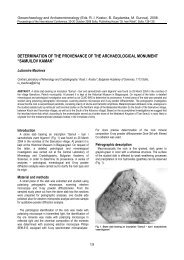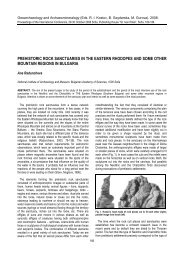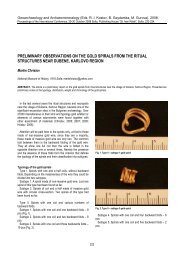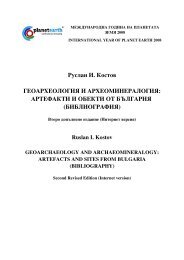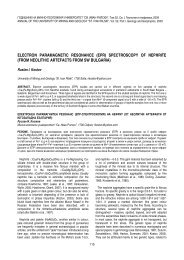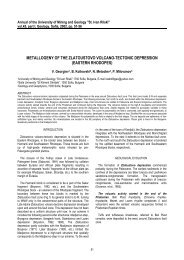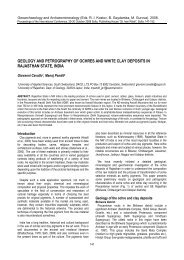Geological Aspect of the Problem Dating the Great Egyptian Sphinx
Geological Aspect of the Problem Dating the Great Egyptian Sphinx
Geological Aspect of the Problem Dating the Great Egyptian Sphinx
You also want an ePaper? Increase the reach of your titles
YUMPU automatically turns print PDFs into web optimized ePapers that Google loves.
A new point <strong>of</strong> view, concerning <strong>the</strong> age <strong>of</strong> <strong>the</strong> <strong>Sphinx</strong>, has<br />
appeared recently. It belongs to geologist R. Schoch (2005);<br />
he has found traces <strong>of</strong> water on <strong>the</strong> surface <strong>of</strong> <strong>the</strong> GES. He<br />
supposes that <strong>the</strong> problem is in <strong>the</strong> rain water. Climatic<br />
conditions characterized by high humidity and pouring rains<br />
may have taken place 13000 years BC. But even this age<br />
border, is not <strong>the</strong> date <strong>of</strong> construction, since <strong>the</strong> <strong>Sphinx</strong> had<br />
already been standing in <strong>the</strong> Giza Plateau by <strong>the</strong> beginning <strong>of</strong><br />
<strong>the</strong> period <strong>of</strong> pouring rains.<br />
In order to study <strong>the</strong> geological situation and to specify <strong>the</strong><br />
role <strong>of</strong> possible factors for <strong>the</strong> destruction <strong>of</strong> GES, one <strong>of</strong> <strong>the</strong><br />
authors <strong>of</strong> this report has made a visual investigation <strong>of</strong> <strong>the</strong><br />
monument on <strong>the</strong> spot (in <strong>the</strong> Republic <strong>of</strong> Egypt). After a<br />
detailed analysis <strong>of</strong> <strong>the</strong> GES surface morphology and after<br />
reading <strong>the</strong> literary sources we have come to a conclusion that<br />
<strong>the</strong> statement about <strong>the</strong> influence <strong>of</strong> sand abrasion on <strong>the</strong> root<br />
rocks <strong>of</strong> <strong>the</strong> monument is exaggerated.<br />
In our geological field expeditions in different mountains and<br />
littoral zones <strong>of</strong> <strong>the</strong> Crimea and Caucasus we could <strong>of</strong>ten<br />
observe <strong>the</strong> forms <strong>of</strong> Eolian wea<strong>the</strong>ring which morphology<br />
differs considerably from <strong>the</strong> wea<strong>the</strong>ring taking place on <strong>the</strong><br />
GES. Most natural forms <strong>of</strong> wea<strong>the</strong>ring are <strong>of</strong> smoo<strong>the</strong>d<br />
character, independent <strong>of</strong> lithological composition <strong>of</strong> <strong>the</strong> rocks.<br />
Our personal experience in scientific investigation <strong>of</strong> geology<br />
<strong>of</strong> <strong>the</strong> sea coasts gives reasons to draw an analogy with <strong>the</strong><br />
GES and to suggest ano<strong>the</strong>r mechanism <strong>of</strong> its destruction.<br />
Specialists-geologists, who work in <strong>the</strong> field <strong>of</strong> sea-coast<br />
geomorphology, know such forms <strong>of</strong> relief as wave-cut hollows<br />
(Morskaya Geomorfologiya, 1980). They can be one- and<br />
multi-storey. They are arranged horizontally to <strong>the</strong> sea water<br />
surface, if <strong>the</strong> coast makes a vertical wall (cliff). Especially<br />
deep wave-cut hollows are formed in precipitous cliffs built by<br />
<strong>the</strong> strata <strong>of</strong> carbonaceous rocks. Such forms <strong>of</strong> <strong>the</strong> coast<br />
relief are well-known and studied in detail on <strong>the</strong> Black-Sea<br />
coast <strong>of</strong> <strong>the</strong> Caucasus and Crimea (Popov, 1953; Zenkovich,<br />
1960). General model <strong>of</strong> formation <strong>of</strong> <strong>the</strong> wave-cut hollows in<br />
<strong>the</strong> rocks <strong>of</strong> <strong>the</strong> Caucasian flysch is given by Popov (1953,<br />
162; Fig. 3).<br />
In dynamics <strong>of</strong> <strong>the</strong> process <strong>of</strong> wave-cut hollows formation<br />
one can notice such a characteristic feature that <strong>the</strong> wave<br />
energy is directed to <strong>the</strong> rock stratum at <strong>the</strong> level <strong>of</strong> water<br />
surface. Besides, both saline and fresh water can dissolve <strong>the</strong><br />
rocks.<br />
Tseiner (1963) noticed that underwashing <strong>of</strong> <strong>the</strong> coastal<br />
walls with formation <strong>of</strong> hollows is an important erosion<br />
indication which may be used for defining <strong>the</strong> old shoreline.<br />
The hollow altitude relative to <strong>the</strong> sea level in <strong>the</strong> time <strong>of</strong><br />
formation varies depending on <strong>the</strong> water surface level. The<br />
hollows altitude can also correspond to <strong>the</strong> upper water mark.<br />
Under natural conditions <strong>the</strong> levels <strong>of</strong> water-cut hollows can be<br />
both above and below <strong>the</strong> water surface. The water-cut<br />
hollows are formed, as a rule, under transgression, i.e. under<br />
sea tide. The transport <strong>of</strong> <strong>the</strong> horizontal sea water surface<br />
occurs both gradually and discontinuously, and <strong>the</strong> hollow<br />
formation lasts for hundreds and even thousands <strong>of</strong> years. An<br />
analogy with wave-cut hollows gives reasons to think that <strong>the</strong><br />
formation <strong>of</strong> <strong>the</strong> GES hollows took place under its long-term<br />
submersion in high water. The Nile seasonal floods could not<br />
play any considerable part.<br />
Limestones, dolomite limestones with small interlayers <strong>of</strong><br />
clay (Rushdi, 1965) <strong>of</strong> Eocene age prevailed in <strong>the</strong> geological<br />
structure <strong>of</strong> <strong>the</strong> GES. These rocks possess different degree <strong>of</strong><br />
resistance to <strong>the</strong> wave effect. If <strong>the</strong> hollows formation were due<br />
to sand abrasion only, <strong>the</strong> hollows had to correspond to <strong>the</strong><br />
strata <strong>of</strong> a certain lithological composition. The GES hollows<br />
are formed in fact within several strata, or occupy some part <strong>of</strong><br />
<strong>the</strong> stratum <strong>of</strong> homogeneous composition (Fig. 4).<br />
The formation <strong>of</strong> wave-cut hollows in <strong>the</strong> massif <strong>of</strong> rocks<br />
composing <strong>the</strong> GES was a process directed from <strong>the</strong> bottom to<br />
<strong>the</strong> top, which means <strong>the</strong> adjustment <strong>of</strong> <strong>the</strong> highest deep<br />
hollow to <strong>the</strong> maximum level <strong>of</strong> <strong>the</strong> monument submersion<br />
(Fig. 5). The back part <strong>of</strong> <strong>the</strong> head and <strong>the</strong> body surface were<br />
in <strong>the</strong> zone <strong>of</strong> <strong>the</strong> least effect <strong>of</strong> waves but <strong>the</strong> waves left <strong>the</strong>ir<br />
traces even <strong>the</strong>re (rain traces, according to Schoch).<br />
The absolute mark <strong>of</strong> <strong>the</strong> territory in <strong>the</strong> Giza Plateau region<br />
(149 m above <strong>the</strong> present sea level from <strong>the</strong> data <strong>of</strong> physicalgeographical<br />
map <strong>of</strong> Egypt, 1965) as well as <strong>the</strong> mark <strong>of</strong> <strong>the</strong><br />
upper deep hollow from <strong>the</strong> GES foot being allowed for; it<br />
would be about 160 m above <strong>the</strong> present sea level. In this<br />
connection <strong>the</strong>re arises a question, when could have <strong>the</strong> GES<br />
been submerged and what kind <strong>of</strong> water body it was.<br />
Geologists <strong>of</strong> <strong>the</strong> Republic <strong>of</strong> Egypt (Rushdi, 1965) and o<strong>the</strong>r<br />
countries have established, when studying <strong>the</strong> sedimentary<br />
series adjoining <strong>the</strong> Giza Plateau, that from <strong>the</strong> end <strong>of</strong> Pliocene<br />
<strong>the</strong> lacustrine deposits represented by alluvium <strong>of</strong>ten occurred<br />
<strong>the</strong>re. They had considerable thickness in geological crosssections<br />
and covered vast territories.<br />
Fig. 3. Scheme <strong>of</strong> development <strong>of</strong> wave-cut hollows in <strong>the</strong> rocks <strong>of</strong> <strong>the</strong><br />
Caucasian flysch (Popov, 1953)<br />
Fig. 4. A fragment <strong>of</strong> <strong>the</strong> <strong>Sphinx</strong> surface composed by <strong>the</strong> rocks <strong>of</strong><br />
various lithological compositions<br />
309



